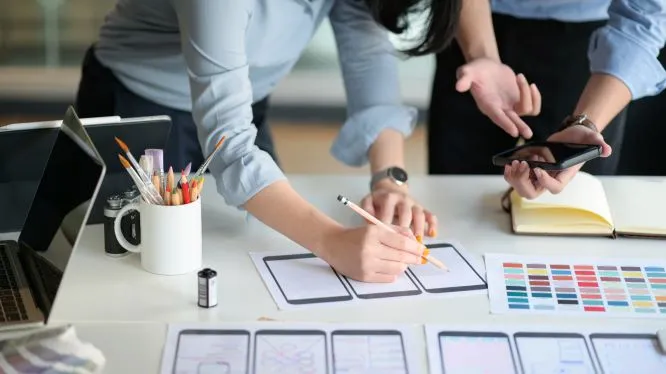Everything is getting digitalize because of the convenience and accessibility that we are getting out of it. From anywhere, in the home or on-the-go, we can access everything from shopping to education with just a simple click. Nowadays, getting a hold on your finances and cash flow is also important for business owners and professional accountants. According to statistics, here are some facts that should be considered for the popularity of Fintech apps.
65.3% of Americans will be using Digital Banking by 2022
66.7% of people around the globe will be using digital wallets and mobile banking apps by the end of 2020.
Fintech will take 33.3% of loan granting and applying process in the USA by 2022.
Another report stated that the adoption of finance apps has increased by 354% over the past five years.
More and more financial sectors and companies are endeavoring to improve the digital experience for the customers. Increased demand for such services is the reason why Fintech and Regtech domains are continually growing all around the world.
In this article, we will discuss in detail about the Fintech apps, their usage, features, and how to build a mobile Fintech app.
So, let’s begin:
Why we need payment solution apps?
There are many benefits and usage attached to an online payment solution app. Some of these advantages are listed below for your reference.
- A mobile payment solution app can help a business achieve better cash flow management. With a Fintech app system integrated into a company, the stakeholders are aware of every transaction. They can take advantage of mobile apps to check-in and out of cash from the business account.
- With the help of mobile payments, small businesses can reduce costs, such as bank charges, excessive staff to monitor transactions and other overheads, and a better evaluation of their cash flow position.
- Being the most convenient way, mobile devices' popularity has increased immensely. Everything is available online. To make the buying and selling process easy on mobile devices, these mobile payment solution apps are essential.
- Companies are eager to develop a more improved version of online shopping apps to compete in a tight market. Better and easy-to-use payment solution apps will attract more customers.
The appetite for Fintech apps is steadily growing. Over the past decade, banking applications have ceased to be an exclusive domain of the young and the tech-savvy. They have earned their place in every generation’s financial management routine. In many respects, Fintech mobile apps have taken over many activities formerly performed only by tellers, and such apps will only keep gaining more traction.
Benefits of Fintech Applications for Businesses and Customers
A Fintech app is mutually beneficial for a business and its customers. Without getting it delayed, let’s have a look at some of these benefits.
Low Cost of Development and Maintenance
Fintech apps not only provide customer feasibility but also help reduce the cost of development and maintenance for companies. If a company develops a separate app for iOS and Android platforms, it will cost them twice as much as building a Fintech app using cross-platform options available such as Cordova, Xamarin or React Native. Since the first two solutions are not popular among developers and offers low experience for users, choosing React Native is a much better option. Also using React Native for mobile financial app development can lower the cost even up to 60 %.
Economic Benefits of Fintech Apps
Fintech apps provide considerable benefits to the economy. Businesses, especially small and medium-sized businesses, are very crucial to economic growth. These SMEs face the most difficulties in securing the financing they need to survive and prosper. With the Fintech app, not only are they saving development costs, but they would also save the cost of hiring people to manage cash flow and manage finances. With Fintech apps, data aggregators can synchronize financial data from various financial institutes to one single platform helping to reduce the compliance costs for businesses.
Improving Customer Experiences
With so much feasibility to conduct transactions through smart devices such as mobile phones, tablets, laptops, and other, Fintech apps are making the customer experience more productive and pleasurable.
Stimulating User Engagement
With Fintech apps comes Push Notification, which helps to stimulate user engagement by providing them info about transactions/costs on their account. They are also very useful when targeting specific users with some information or marketing data.
After having a brief introduction of the benefits we can reap from Fintech Apps, it’s time to understand what features make the best Fintech app.
Try our developers.
Free for 2 weeks.
No risk. Just results. Get a feel for our process, speed, and quality — work with our developers for a trial sprint and see why global companies choose Selleo.
What are the core features of a successful Fintech mobile app?
Like any other app, the popularity of the platform depends on the feature that it offers to the customer. Based on our research, here’s the list of top feature that makes the best Fintech mobile app.
Simple-to-Use and Understand
Fintech apps give power to customers so they can avail of advanced services to manage their financial operations. One of the most essential ingredients for the success of any Fintech app is its simplicity.
The idea of any Fintech mobile app is to provide simple analytical tools that compile financial data, display transaction histories, and create financial programs with a simple interface. Every Fintech app should have real-time analytics and statistics that track finances, helping users and their companies recover revenue.
The apps should also include ID analytics to minimize user risks. To make the app more attractive to clients, financial sectors now including features to make the processes of money borrowing and private debt deal investments much easier compared to the standard bank credit application.

Protection and Security of Sensitive Data
Fintech apps are designed to deal with the most sensitive data of customers involving financial transactions. Privacy and security of users’ data is the priority to address. Rapidly increasing cyber threats and attacks have made users less confident in Fintech apps. The company should not only meet regulation and compliance policies but also need to provide full cybersecurity to the users.
Typical security features include:
- Lockout of the profile after the third failed login attempt. However, the limit should be 6 attempts if one’s has to be PCI compliant.
- The app should always ask to reenter the password while updating any information in the profile.
- Display only the last three digits of the Credit/Debit Cards.
- Integration of voice and face recognition.
- Integration of fingerprint authentication in addition to 2-Factor Authentication.
Blockchain and Cryptocurrency
Blockchain or Cryptocurrency has taken over the financial world after the popularity of BitCoin. Although the payment method has not yet become global because of a lot of prudential aspects attached to it. Blockchain, along with other functionalities, is also an anonymous payment method where data packets have been transferred without letting anyone know its origin. This payment option is yet not approved by many government authorities, yet some financial sectors have adopted it.
API Integration
Application Programming Interface is the basic foundation of building an online platform. It allows large applications by integrating multiple platforms without rebuilding each one of them again and again. A modern online form or SaaS may be combined with dozens of APIs from the same ecosystem without the end user even knowing it. It is the API that lets developers add functionality where a user can tap on geolocation to find a nearby ATM.
The importance of APIs in Fintech apps are already heavily used to provide partially automated due diligence, KYC/AML processes.
Support
Companies need to add 24/7 live chat or ticket support in Fintech apps. Someone likes the interaction with humans; others prefer chatbots. To manage time and cost, companies can combine them both. Build a reliable support service to provide a helping hand to everyone in need.
Give Power to the Customer via Personalization
Your every customer is different with different needs. But understanding the customer’s taste is what makes your product unique. The Fintech app should provide a personalized experience to its users. Fintech apps help companies and business to gather the data of customer taste and buying trends and later analyze it to create a personalized app for users. Fintech app integration with personal applications, including social media, establishes the strongest possible relationship with the user. As a result, financial operations are more enjoyable and bring people closer together.
Let’s look at the step-by-step process of creating a Fintech app.
How to build Fintech Mobile App – Step by Step Guide
Fintech app development is not a child’s play. It needs a lot of technical knowledge. So, you would need to hire a well-experienced team of developers who have exposure in the same field. Just to brief the procedure to you, here’re the steps involved in creating a Fintech app.

Step # 1: Do your research and make a plan for the look and features of the app. You need to define the scope of MVP and overall features. You also need to validate your idea based on availability.
Step # 2: You need to form a team of developers, either in-house or outsourced, to develop the app. The communication process between the developer and you should be crystal clear.
Step # 3: You need to choose your technology stack. What does it mean? Well, there are many languages to design applications. You can select between native technologies for Android [like Java and Kotlin], iOS [like Swift or Objective C]. As discussed earlier, both the apps will be developed separately, which will increase the development cost.
The second approach is to build PWA (Progressive Web App) - it might generate the native feel of an app but doesn’t allow us to use native mobile features like biometry.
The third and most recommended approach that will save 60% of your cost is to design the app using Cross-platform app development - it allows you to write only one codebase for both platforms (iOS and Android). Next, it is transpired to the platform-specific native language.
Step # 4: Design UI/UX of your app with vibrant colors and easy-to-use functionality. The app should not be crowded with unnecessary features. It should have everything available on the dashboard without having a hunt for options.
Step # 5: Test your app by launching a Beta phase to a selected number of loyal customers or within the organization to gather feedback. Later, once the app is bug-free, you can launch it in the market officially.
Step # 6: With the latest innovations and on-going changes in the IT sector, you will need to Improve and update your application time-to-time.
If you decide to go with an outsourced developer team, then Selleo is one option you should consider. Here’s how we create mobile payment solutions.
How we create Fintech applications?
At Selleo, we have a team of highly-experienced professionals for UI/UX design, Customer Software Development, DevOps & Cloud Consulting, APIs Development. We aim to assist our clients with customized and personalized technical specification development. While working with many clients over the years, we have gathered business insight, which helps us to provide custom Fintech applications with API integrations and developing web solutions for industries in which regulatory compliance is a key.
We create successful mobile payment apps in react-native because it offers several nice features like:
- Code reusability
- A large community of developers
- It offers optimal performance
- Reduce Development cost
- Personalized and simple UI
- Third-Party Plugin Support
What Common Issues Business Can Resolve via Selleo Fintech App
Our motive was to build an app that allows users to take a snap of transaction receipts and upload them through the mobile application. We aimed to develop an option through which a company can control their finance and communicate with the workforce (users) by notification displays. It can be a message from the company to the customer through firebase cloud messaging or vice versa.

The application allows changing its layout to be looking like the cooperating company wants to.
We also assist our users in integrating security features like biometry verification, uploading pictures right from the device, sending push notifications, and contacting integration that is unavailable on the browser.
Summing Up
Fintech applications have taken the financial world by storm. Becoming one of the greatest opportunities for many business and application developers. It is said that traditional organizations will collaborate with Fintech companies 80% more times in the next 3 to five years. Having an opportunity of creating the Mobile Payment Applications using react-native that reduced the cost of development attracted the financial institutions more toward Fintech Apps.
Moreover, with Fintech apps, customers have a much better experience and feasibility of conducting their financial transactions.
If you are considering developing your Fintech app, you should better consider all the points we covered in this article. You can also contact us for more help and hire an experienced developers team.





